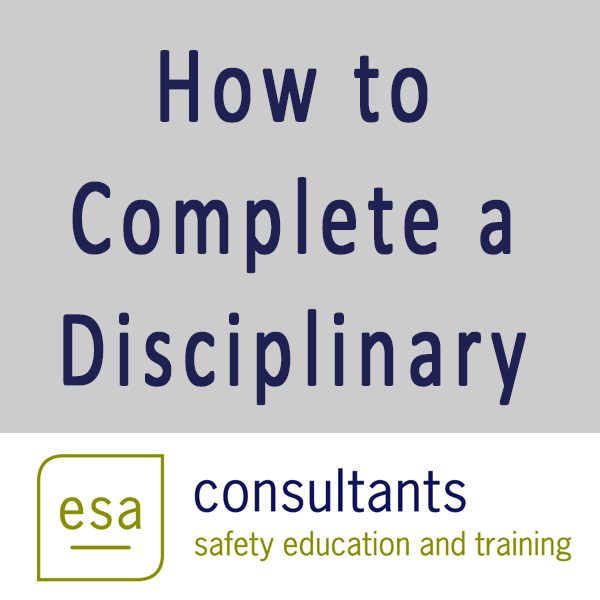Description
Aim:
The purpose of disciplinary procedures is to maintain standards of conduct, behaviour, performance, attendance etc in the workplace. The procedures supports the Company’s policies and procedures and good management.
Duration:
1 Day
Course Objectives:
An employer is responsible to ensure that the disciplinary procedures are effective, fair, well understood and consistently applied.
The stages are as follows:
- Investigating the offence – this may also include meeting with witnesses and gathering their statements
- Disciplinary hearing
- Appeal
Location:
Course Details
Guidelines for Conducting Disciplinary Investigation & Hearings
All dismissals are deemed unfair by the labour court and in the labour court it will be up to the respondent company to prove that any dismissal is fair.
In many cases, it is often the procedural aspects that leave the company exposed and unable to fully defend its case for dismissal. i.e. the EAT will often find there was a breach of procedures and they may result in a determination of unfair dismissal.
Stages in the disciplinary process
The following guidelines apply to all disciplinary hearings under all the stages of the formal disciplinary procedure, namely, the:
• oral warning stage
• written warning stage
• final written warning stage
• dismissal stage
Notification Requirements
The employee should be notified that s/he is required to attend a disciplinary hearing under the formal disciplinary procedure.
The employee should be advised of:
• the reason for the hearing
• the right to representation. The employee should be given sufficient notice of the hearing to enable him/her to arrange for representation and prepare a response. Best practice indicates that employees should be provided with a minimum of 24 hours notice.
The following information should be confirmed (preferably in writing):
• The time and place of the hearing
• The status of the meeting (i.e. that it is a formal disciplinary hearing under the disciplinary procedure)
• The precise nature of the complaint / the issue being dealt with
• Copies of any documentation that will be relied upon at the hearing (e.g. attendance, timekeeping, performance record) must be provided to the employee in advance of the hearing
• The right of the employee to be accompanied by a representative (work colleague or union representative)
• The employee will be allowed an opportunity to respond to the allegations and to present any mitigating circumstances in their defence
• That a full investigation will be held where this is warranted
The employee should also be furnished with a copy of the organization’s disciplinary policy and procedure (they would of course already received a copy on commencement of employment and possibly received further updates since then).
The purpose of the disciplinary hearing is to allow the employee to respond to the complaints before deciding whether disciplinary action is warranted. The managers conducting the hearing must not pre-judge the outcome of the hearing and are required to assess each case on its merits prior to reaching a decision regarding disciplinary action.
The Hearing
The disciplinary hearing should follow a structured format as follows:
• Introduce those present
• Confirm that this is a hearing under the formal disciplinary procedure.
• Where an employee has waived their right to representation, offer the right to representation one last time. Where the offer is rejected, take note of this.
• Outline the nature of the complaint and refer to any supporting evidence, documentation, etc
• Allow the employee to respond to the complaint and give an explanation for his/her unsatisfactory work standards, conduct or attendance.
• Invite representations on the employee’s behalf.
• Direct any questioning of the employee towards establishing his/her view as regards the alleged offence. Elicit any mitigating circumstances that the employee may be able to present in their defence. It is important to focus on the factual information and to remain professional, calm and composed throughout.
• Where the employee becomes emotional (angry, aggressive, upset, teary, etc), it may be prudent to take a short adjournment and return to the hearing a few minutes later.
• Close the hearing by summarising the key points emerging from the hearing and allow the employee and his/her representative to have a final say.
• Adjourn the meeting to allow for careful consideration of the facts and any explanations put forward by the employee or his/her representative.
• Inform the employee as to when the parties will reconvene with a decision.
The Adjournment & Consideration of the Facts
• After the hearing has been adjourned, the managers must carefully consider the facts, mitigating circumstances and any explanations put forward by the employee or his/her representative.
• Following careful consideration of the facts, explanations and any mitigating circumstances, the managers make a decision about what disciplinary action is required, if any.
The Reconvening & Announcement of the Decision
The hearing is reconvened and the employee is advised of the decision which may include the following:
•No further action on the grounds that the employee has given a satisfactory explanation of events or there were strong mitigating circumstances;
•Non-disciplinary action, e.g. arrange for the employee to receive coaching/training and set targets for improvement
•A formal warning (stage 1, 2 or 3. Please note that, stage 1 – oral warning, is a formal written warning as are stages 2 and 3)
•Dismissal (stage 4);
Should the decision be a formal warning, the warning (oral or written stages) should be conveyed to the employee to include the following information:
•the stage of the disciplinary procedure which has been invoked
•details of the unsatisfactory attendance, conduct or work standards
•details of the improvements required and timescale for improvement including a performance improvement plan if appropriate and when it will be reviewed
•measures to assist the employee (e.g. training or coaching)
•duration of the warning
•what further action will be taken if the employee does not make the necessary improvements or if there are further instances of unsatisfactory attendance/work/conduct during this period
•the organization’s appeals procedure which the employee may invoke
The Written Follow-Up
The outcome of the hearing should be confirmed to the employee in writing. This applies to all stages, stages 1-4, including stage 1 – oral warning, which does in fact require you to follow-up in writing).
The written warning will give details of the complaint, the improvements required and the timescale for improvement. The employee will also be advised that failure to improve may result in a further disciplinary hearing and in the issuing of further warnings or a dismissal under the next stage of the disciplinary procedure. The warning will be removed after a period of time (which is stated in the disciplinary procedure), subject to satisfactory improvement during this period.
The warning (oral or written stages) should convey the following information:
•the stage of the disciplinary procedure which has been invoked
•details of the unsatisfactory attendance, conduct or work standards
•details of the improvements required and timescale for improvement including a performance improvement plan if appropriate measures to assist the employee (e.g. training or coaching)
•duration of the warning
•what further action will be taken if the employee does not make the necessary improvements or if there are further instances of unsatisfactory attendance/work/conduct during this period
•the organization’s appeals procedure which the employee may invoke
A record of the hearing and the outcome – both oral and written warnings – should be retained on the employee’s personnel file.


